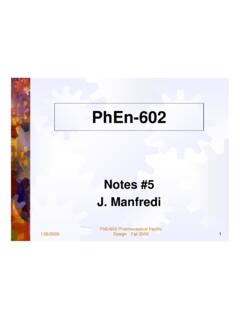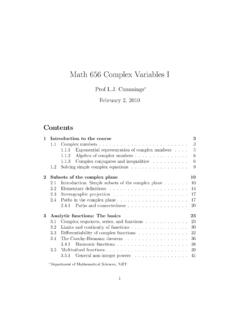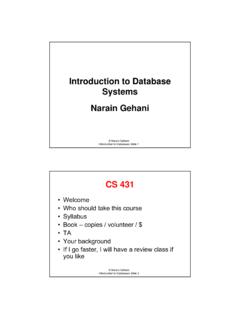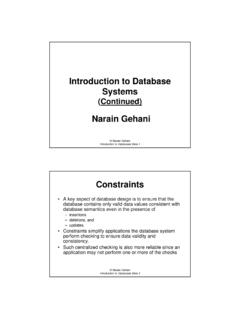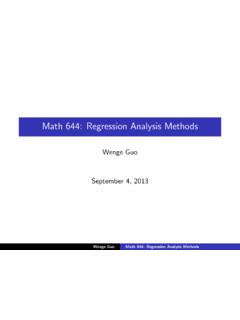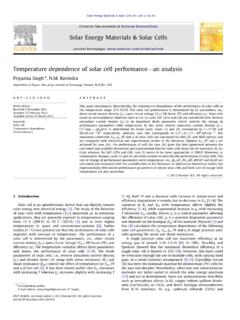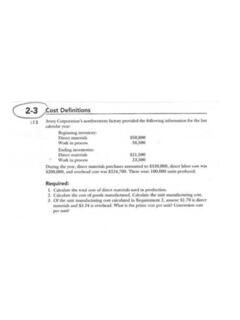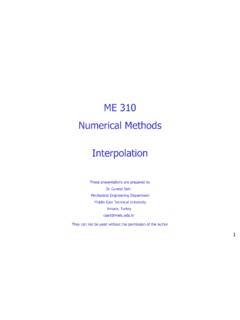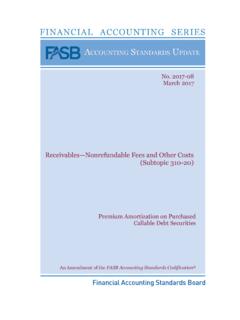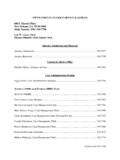Transcription of Lecture #6 Chapter 4 - New Jersey Institute of Technology
1 BME 310 Biomedical Computing and AliasingLecture #6 Chapter 4 BME 310 Biomedical Computing Is this Course All About ? To Gain an Appreciation of the Various Types of Signals and Systems To Analyze The Various Types of Systems To Learn the Skills and Tools needed to Perform These Analyses. To Understand How Computers Process Signals and SystemsBME 310 Biomedical Computing Signals and Computers Up to now we have been studying continuous-time signals (also called analog signals) such as However, digital computers and computer programs can not process analog signals. Instead they store discrete-time versions of analog signals This is because digital computers can only store discrete numbers.
2 There are computers called analog computers which do process continuous-time signals Since the computer only stores numbers, how does one know what continuous-time signal it represents?( )cos()oxtAt )(][snTxnx BME 310 Biomedical Computing We can obtain a discrete-time signal by sampling a continuous-time signal at equally spaced time instants, tn= nTsx[n] = x(nTs) - < n< The individual values x[n] are called the samples of the continuous time signal, x(t). The fixed time interval between samples, Ts, is also expressed in terms of a sampling rate fs(in samples per second) such that: fs= 1/ 310 Biomedical Computing Conversion By using a Continuous-to-Discrete (C-to-D) converter, we can take continuous-time signals and form a discrete-time signal.
3 There are devices called Analog-to-Digital converters (A-to-D) The books chooses to distinguish an C-to-D converter from an A-to-D converter by defining a C-to-D as an ideal device while A-to-D converters are practical devices where real world problems are evident. Problems in sampling the amplitudes accurately Problems in sampling at the proper timesBME 310 Biomedical Computing Signals A discrete-time signal is a sequence of numbers and carry no information about the time-sequence. Looking at the following diagram, which (gray or solid) waveform are these (red) samples associated with? 310 Biomedical Computing Sinusoidal Signals Since a Fourier series can be written for any continuous-time signal, let s concentrate on sinusoids We define a normalized frequency for the discrete sinusoidal signal.
4 Is the normalized or discrete-time frequency Since we can have different signals with the same , then there can be an infinite number of continuous-time signal which yield the same discrete-time sinusoid! [] ( )cos() cos() ssssxnxnTAnTAnTf BME 310 Biomedical Computing Problems with Sampling Problem 1: How many samples are enough to have to represent a continuous time signal? In this figure, we have a continuous-time signal sampled every .4 seconds (red samples) and every 1 second (black samples).-1010246810 BME 310 Biomedical Computing Sinusoidal Signals Problem 2: Can a set of samples be represent more that one continuous-time signal 4.)1)( (2 -1010246810 The discrete-time sinusoid shown in the figure has which can be obtain from, for example, either a 1 second sampled continuous-time sinusoid with f = Hz or Hz.
5 In the first case, where f = Hz, we have: BME 310 Biomedical Computing Sinusoidal Signals 4.)1)( (2 []cos() 2 ( )(1) [ ]cos( )cos( )cos( )xnAnxnAnAnnAn -1010246810 In the first case, where f = Hz, we have: Since a sinusoid is periodic in 2 , then for the case where f= HzBME 310 Biomedical Computing This example illustrates that two sampled sinusoids can produce the same discrete-time cos [2 ( ) t]2. cos [2 ( ) t]-1010246810 When this occurs we say that that these signals are aliases of each 310 Biomedical Computing There are more alias signals for this example:1. x(t) = cos (2 ( ) t) =>x[n] = cos (2 ( ) 1n) = cos ( n) 2. x(t) = cos (2 ( ) t) =>x[n] = cos (2 ( ) 1n) = cos ( n) = cos ( n+ 2 n) = cos ( n) 3.
6 X(t) = cos (2 (.8) t) =>x[n] = cos (2 (.8) 1n) = cos ( n) = cos (2 n) = cos ( n) In summary, (for l= positive or negative integer): 0,1,2,3,for ),cos()-cos(2 Since0,1,2,3,for llllll -1010246810 o, o 2 l, 2 l owhere o is called the principal aliasBME 310 Biomedical Computing Let s look at signals of the form: cos( lt)Hz 812180 20 ) 2( , , , , 2 Then, .1 and is example,our In 2) 2( and 2or 2) 2( and 2 havecan then we,)2cos()cos()cos( since2)2 ( and )2 ( Therefore, is and alias, principal theis ,2 and where ) cos()cos(, .., ..,.llflfllfflflflflflfflfllfTntsololsos ololsololsolsoslloolslslllsampledl BME 310 Biomedical Computing s Sampling Theorem How frequently do we need to sample?
7 The solution: Shannon s Sampling Theorem: A continuous-time signal x(t) with frequencies no higher than fmaxcan be reconstructed exactly from its samples x[n] = x(nTs), if the samples are taken a rate fs= 1 / Tsthat is greater than 2 fmax. Note that the minimum sampling rate, 2 fmax , is called theNyquist 310 Biomedical Computing of the Discrete-time There are an infinite number of frequency components of discrete-time signal They consists of the principal along with the other aliases (an infinite number of them).BME 310 Biomedical Computing Rate Shannon s theorem tell us that if we have at least 2 samples per period of a sinusoid, we have enough information to reconstruct the sinusoid.
8 What happens if we sample at a rate which is less than the Nyquist Rate? Aliasing will occur!!!!BME 310 Biomedical Computing Reconstruction The sampling theorem suggests that a process exists for reconstructing a continuous-time signal from its samples. If we know the sampling rate and know its spectrum then we can reconstruct the continuous-time signal by scalingthe principal aliasof the discrete-time signal to the frequency of the continuous signal. The normalized frequency will always be in the range between 0~ and be the principal alias if the sampling rate is greater than the Nyquist 310 Biomedical Computing Reconstruction Continued If continuous-time signal has a frequency of , then the discrete-time signal will have a principal alias of So we can use this equation to determine the frequency of the continuous-time signal from the principal alias.
9 Note that the normalized frequency must be less than if the Nyquistrate is used And the reconstructed continuous-time frequency must bessfT ssTf )2(222 MAXsMAXsMAXsMAXsMAXfffffTfTmax 2222ssssfffffff BME 310 Biomedical Computing When we sample at a rate which is greater than the Nyquistrate, we say we are oversampling. If we are sampling a 100 Hz signal, the Nyquist rate is 200 samples/second =>x(t)=cos(2 (100)t+ /3) If we sample at times the Nyquist rate, then fs= 500 samples/sec This will yield a normalized frequency at 2 (100/500) = 310 Biomedical Computing Since we are greater than the Nyquist rate, the normalized frequency will be < which means it is the principal alias.
10 And we get back the original continuous frequency when we do the reconstruction f= fs/ 2 = 500 / 2 = (500) = 100 310 Biomedical Computing and Aliasing When we sample at a rate which is less than the Nyquist rate, we say we are undersampling and aliasing will yield misleading results. If we are sampling a 100 Hz signal, the Nyquist rate is 200 samples/second =>x(t)=cos(2 (100)t+ /3) If we sample at .4 times the Nyquist rate, then fs= 80 s/sec This will yield a normalized frequency at 2 (100/80) = 310 Biomedical Computing Since it is > , is NOT the principal alias The principle alias is -2 = Using as the principal alias and performing a reconstruction we then have:f= fs/ 2 = 80 / 2 = (40) = 20 Hz and we have reconstructed the wrongsignal!

